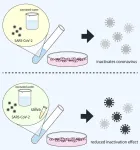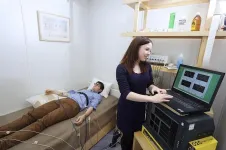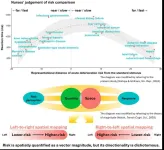(Press-News.org) by Nishith Mishra, Martina Elia Vitoloni, and Dr Joseph Pelton
Mining ocean resources needed for electric cars and other devices is currently a hot issue of dispute. Final resolution of how or whether the seabed should be expl18oited is pending. Outcomes in this contentious area could create precedents that could impact decisions about mining the moon.
These precedents might shape the how and why of mining the Moon and shape the future and the sustainability of space activities of human beings. But this is only one possible precedent that could reshape the future of space.
Pending international discussions on space traffic management, space debris removal, and limiting so-called space junk in Earth orbit could help to stop space debris orbiting the Moon and Mars. This essay by the authors is a plea that we learn from our mistakes and create a more sustainable way forward in outer space.
Lessons we should learn from space debris management
This mounting problem in Earth orbit represents yet another area where precedents for the future of space may well be established. Many countries now back what is called space traffic management and active debris control. This has been recommended in the findings at the recent UN ‘Summit on the Future.’ Without action by the UN Committee on the Peaceful Uses of Outer Space (UN COPUOS), however, there is the potential danger of rendering entire orbits unusable. These dangers are now aggravated through the deployment of so-called satellite mega-constellations- or constellations of thousands of satellites in Earth orbits.
Moreover, the current count of tracked objects greater than 10 cm is 40,500 space debris objects, while there are more than 1,1 million space debris objects larger than 1 cm. Every time there is a major collision in orbit the debris created ranges from 2,000 to 3,000 new elements. Some of the potential for mitigation of this issue lies in collision avoidance capabilities, AI, on-orbit servicing and active debris removal. However, the ongoing deployment of mega-constellation launched by various nations contributes to the saturation of orbits, exacerbating the problem.
There is an ongoing discourse within UN COPUOS for directly addressing space debris. Among the topics under discussion is the potential for a global approach to space traffic management. A consortium of space agencies including NASA, JAXA, Roscosmos, and ESA, among others, has also contemplated how this might be accomplished.
Today the COPUOS guidelines are the recommended approach, but they are not mandatory and there are no enforcement mechanisms. This inclination towards soft-law documents over binding regulatory and legal approaches stems from states’ reluctance to restrict their freedom of use. Some countries have resisted a space traffic management approach and mandatory procedures, calling such an approach ‘premature’. A legal vacuum has contributed to a worrisome trend.
Dire need for legal regulation
In 2020, NASA drafted the Artemis Accords, a soft-law document companion to the Artemis mission to return to the Moon. Later, the US called for input from other countries. Section 12 of the accords explicitly calls on signatories to limit space debris in the pursuit of the lunar exploration project. Such protective action would help fulfill the obligation contained in Article IX of the Outer Space Treaty which requires that:
“… States parties to the treaty shall pursue studies of outer space, including the Moon and other celestial bodies, and conduct exploration of them so as to avoid their harmful contamination and also adverse changes in the environment of the Earth resulting from the introduction of extraterrestrial matter and, where necessary, shall adopt appropriate measures for this purpose …”
In this sense, the preoccupation for mitigating space debris is no longer restricted to Earth orbit, but to lunar orbit as well.
Leading space-faring nations, including the U.S., India, China, Russia, Japan, and the ESA, have launched satellites to map the Moon. There are plans to send a significant amount of materials to the Moon from Earth, but no plans for subsequent ‘clean up’. As examples, there are ambitious plans to launch a number of satellites to orbit the Moon as well. Additionally, China in collaboration with Russia will likely deploy a space station. ESA has examined a program known as ‘Moonlight’, aimed at deploying a very small constellation of five satellites for telecommunications and navigation. A range of alternative concepts have been advanced, some of which are particularly unconventional. One proposal involves the placement of a captured asteroid in lunar orbit so it might be deployed as a defensive strategy against an impending ‘killer asteroid’.
These proposals for the placement of satellites, space stations, and even asteroids in lunar orbits have not addressed and included with it proposals for removal of these objects from lunar orbit. Humanity’s plans for lunar settlements, mining of the Moon’s resources and other security and military activities in and around Moon orbits do not include provisions for the clean-up and disposal of space objects.
The pollution of Earth, the presence of space debris in Earth orbits, and the planned mining of the ocean floor have not adequately demonstrated the adverse consequences that follow. We need to recognize the pollution of the Moon and its orbits, and then Mars, will entail. We advocate for the need for binding rules to safeguard Earth orbits, plus the orbits of Moon and Mars from space debris contamination. The need today is towards effective action to keep outer space orbital resources safe and sustainable, and for any mining operations be governed by equitable and effective international regulation.
END
Disinfecting surfaces is crucial in keeping bacteria and viruses at bay, but the cleaning solutions could be ineffective if met with neutralizing compounds.
Ozonated water has a strong disinfection effect on mold and bacteria, and is also shown to work on SARS-CoV-2, which is responsible for COVID-19. The downside is that ozonated water breaks down quickly in the presence of organic matter, which reduces its effectiveness. SARS-CoV-2 is transmitted through droplets mixed with bodily fluids, such as saliva and nasal mucus which contain organic matters. For this reason, it is necessary to investigate how effective ozonated water is in the presence of ...
Alcohol-related deaths increased 18% during the pandemic, as did hospitalizations related to alcohol use, according to new research in CMAJ (Canadian Medical Association Journal) https://www.cmaj.ca/lookup/doi/10.1503/cmaj.241146.
In the early part of the pandemic, retail alcohol sales volume in Canada increased by 2% (2020/21 v. 2019), the highest increase in 10 years, despite few international visitors. More than 1 in 4 people (26%) reported drinking more, and 18% reported heavy drinking (defined as ...
The risk of being admitted to the hospital with heart disease is twice as high the year after birth for mothers of twins compared to singleton births, according to research published in the European Heart Journal [1] today (Monday). The risk is even higher in mothers of twins who had a high blood pressure condition during pregnancy.
The research was led by Professor Cande Ananth from the Department of obstetrics, gynecology, and reproductive sciences at Rutgers Robert Wood Johnson Medical School, New Jersey, USA.
He said: “The rate of twin pregnancies worldwide ...
Research led by Lancaster University has revealed clear evidence that changes in the orchestration of brain oxygenation dynamics and neuronal function in Alzheimer’s disease contribute to the neurodegeneration.
The study “Neurovascular phase coherence is altered in Alzheimer’s Disease” is published in Brain Communications. The lead author is Aneta Stefanovska with Juliane Bjerkan, Gemma Lancaster, Peter McClintock and Trevor Crawford from Lancaster University and Bernard Meglič and Jan Kobal from the University of Ljubljana Medical Centre in Slovenia.
Professor Stefanovska said: “Alzheimer's can be hypothesised as being a result ...
It’s a little pill with big responsibilities. But despite its primary role to prevent pregnancy, the contraceptive pill (or ‘the Pill’) could also help reduce the risk of ovarian cancer, according to new research from the University of South Australia.
Screening for risk factors of ovarian cancer using artificial intelligence, UniSA researchers found that the oral contraceptive pill reduced the risk of ovarian cancer by 26% among women who had ever used the Pill, and by 43% for women who had used the Pill after the age of 45.
The study also identified some biomarkers associated with ovarian cancer risk, including several characteristics of red blood ...
2nd February 2025 Greifswald/Aarhus/Helsinki - On time for World Wetlands Day, the European Wetland Map (‘EWM’) significantly enhances knowledge of wetlands across Europe by locating, assessing and merging the latest geospatial data. It combines various geographic information system (GIS) data on wetland types and their distribution on mineral soil in coastal environments, floodplains, and a large variety of peatlands in one most comprehensive, easily accessible resource.
"Over a period of two years, we collected, checked and merged more than 200 geodata on wetlands and especially ...
Ann & Robert H. Lurie Children’s Hospital of Chicago launched a newborn screening awareness campaign, with signage on public transit and billboards across Chicago urging parents to contact their child’s pediatrician immediately if results are out of normal range. For some conditions, such as cystic fibrosis, that are included in newborn screening, timely diagnosis and early treatment are key to optimal health, while delays can lead to more severe disease.
All U.S. states screen for at least 33 metabolic and ...
A new study from the University of Chicago Medicine reveals that people with alcohol use disorder (AUD) and depression experience high levels of stimulation and pleasure when intoxicated, similar to drinkers who do not have depression.
The findings counter the long-held belief that the pleasure people experience when drinking alcohol decreases with addiction and that drinking to intoxication is mainly to reduce negative feelings as a form of self-medication.
"We have this folklore that people drink excessively when they're feeling depressed ...
Tokyo, Japan – Researchers from Tokyo Metropolitan University have studied how nurses perceive words showing high and low risk ailments. They looked for directional bias, e.g. whether words denoting lower (higher) risk led to a quicker response when placed on the left (right) side or vice versa. They found faster response for significantly higher or lower risk, but different people had different directional biases. Their findings might inform better ways to present clinical information.
With every incoming medical emergency, nurses are required ...
High-risk pregnancy specialists from the Raquel and Jaime Gilinski Department of Obstetrics, Gynecology and Reproductive Science at the Icahn School of Medicine at Mount Sinai are presenting research at the Annual Pregnancy Meeting of the Society for Maternal-Fetal Medicine (SMFM) in Denver from January 27- February 1.
The Mount Sinai doctors are available for interview about their research findings, and can also provide commentary on other women’s health topics, breaking news, and studies.
PRESENTATIONS and POSTER SESSIONS
*All abstracts are under embargo until the below listed times*
Thursday, ...



